Starting in the late 1980s, the young Portuguese scientist Luís Rocha Monteiro studied mercury pollution in the marine environment of the Azores. After a few years, he recruited the help of seabirds. From mercury concentrations in their plumage and regurgitations of food, he was able to infer the health of the rest of the ecosystem. Among the birds he studied were band-rumped storm petrels Oceanodroma, which had only recently been proven to breed in the Azores.
Monteiro soon discovered that there were two populations in the islands, one present in the hot season (March to September) and the other in the cool season (August to March). During the early autumn, adults of the cool-season population could often be found in the very same burrows where nestlings of the hot-season population were still growing up. Striking differences in their mercury levels led Monteiro to believe that the two populations might differ in their feeding ecology, and subsequent research showed that they also differed in morphology and egg dimensions. Hot-season birds were smaller in most body measurements, particularly weight, but had longer tails, and proportionally longer wings. A detailed paper was published, raising the exciting possibility that hot- and cool-season populations in the Azores might be cryptic species (Monteiro & Furness 1998). Tragically, Monteiro never had the opportunity to follow the story through. He died in a plane crash on the island of São Jorge in December 1999, when he was still in his late 30s.
Eight years after his death, the dust is still far from settling over Monteiro’s discovery, and the number of different types of band-rumped storm petrel in the North Atlantic has risen to four. They form a classic example of a group of birds whose diversity went unnoticed due to similarity in plumage, despite differences in measurements, the timing of their annual cycle, and DNA. For us it has been a real adventure obtaining sound recordings of each band-rumped and listening to vocal differences. These are so clear that they readily support any appeals for an increased level of conservation for each one. Collectively, they can be referred to as ‘band-rumped storm petrels’. Madeiran Storm Petrel O castro is the hot-season breeder of the Madeiran archipelago, Selvagens and the Canary Islands. Cape Verde Storm Petrel O jabejabe breeds only in the Cape Verde Islands. Monteiro’s Storm Petrel is the hot-season breeder of the Azores, named after its discoverer Luís Monteiro; a formal description of this new taxon will be published shortly (Bolton et al 2008). Grant’s Storm Petrel (not yet formally described) is the cool-season breeder of the Azores, Berlengas, Canary Islands, Madeiran archipelago and Selvagens. This name was suggested by Steve Howell in conversation, in memory of the late Peter Grant who died in 1990.
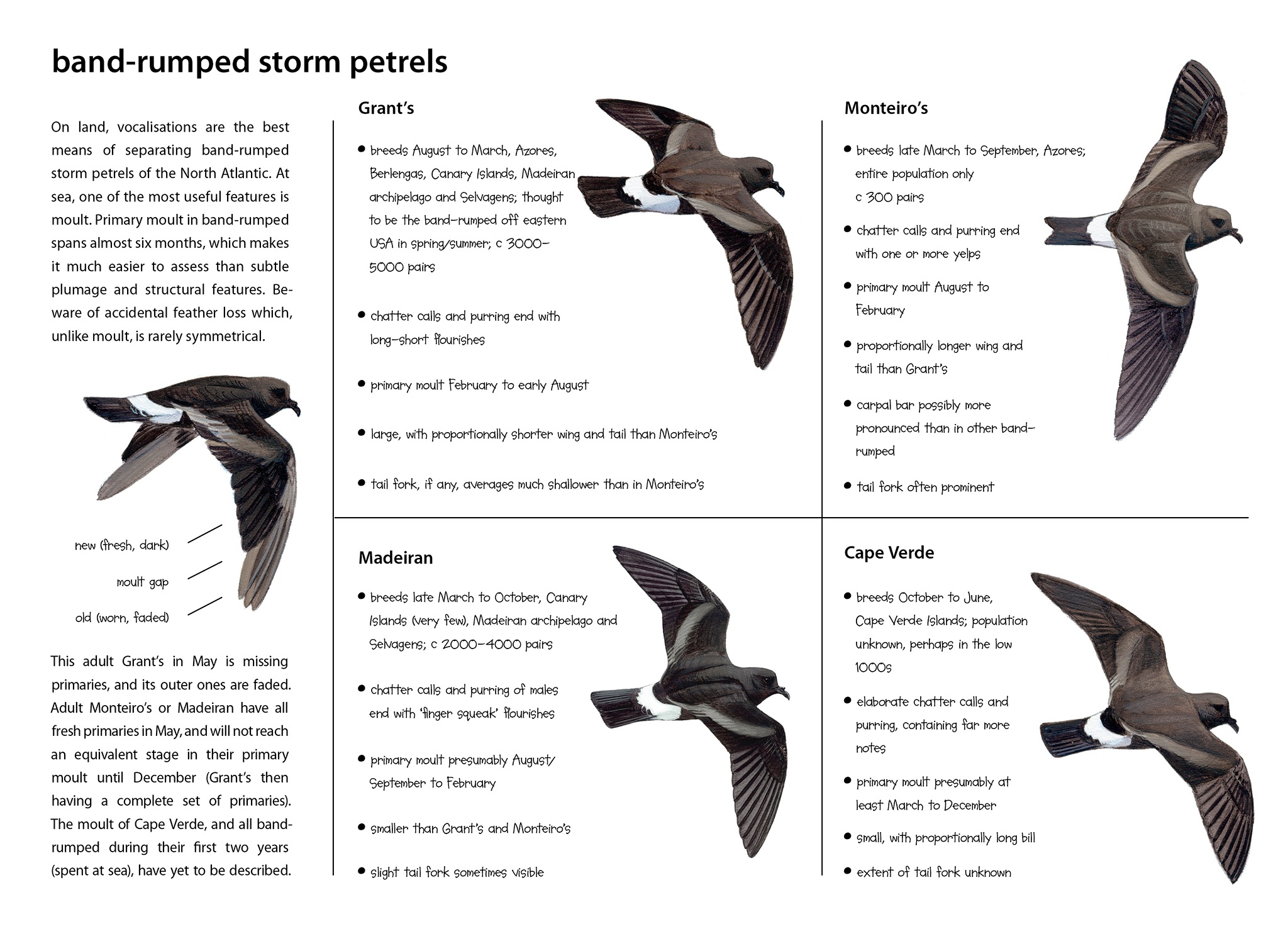
Killian Mullarney
Text by Magnus Robb
present as a breeding bird from at least October to June in the Cape Verde Islands.
Branco means white, and from a long way off, patches of white sandstone on this island’s long, sharp backbone reflect the bright, tropical sun. Near the south-eastern end, where landing is easiest, the steep slopes are covered in countless dark fragments of lava. The chunks nearest to the shoreline are sizeable boulders, but the higher you go, the smaller the rocks become. This is ideal habitat for Cape Verde Storm Petrels, endemic to the archipelago, and not yet recorded with certainty anywhere else.
I first suspected they might be something special when I listened to all the recordings available to me in 1999, just after George Sangster’s article about band-rumped storm petrels appeared. A CD-ROM of the Birds of the Western Palearctic (OUP 1998) contained chatter calls from Raso, Cape Verde Islands, which sounded very different from any other published recording of band-rumped. In February 2004, Arnoud van den Berg and I visited Branco, and we heard Cape Verde Storm Petrels for ourselves. Our visit lasted just one night, and we only heard a handful of callers. To me, they sounded very distinctive. Unfortunately, our recordings were spoiled by strong wind and roaring surf, so the next time I travelled to the Cape Verde Islands, I hoped for better luck.
During the first three nights of our March 2007 visit, we stayed on Raso. I managed to record Cape Verde Storm Petrels a long way from the crashing waves, but there were never more than two or three calling at once. At other times of the year, I suspected there must be many more, because their bones were scattered over large areas of suitable habitat. Branco was a completely different story, and I’m still struggling to understand why. It was hardly even dark when the first storm petrels called as they flew in over the beach. Realising this was a very good sign, I headed up to the steep, rock-strewn slopes, in the hope of hearing a few more. During the time it took me to get there, their numbers swelled, and soon I could hear calls of many hundreds, perhaps even thousands. A fantastic aerial performance began, and I doubt whether I have ever heard so many storm petrels anywhere else.
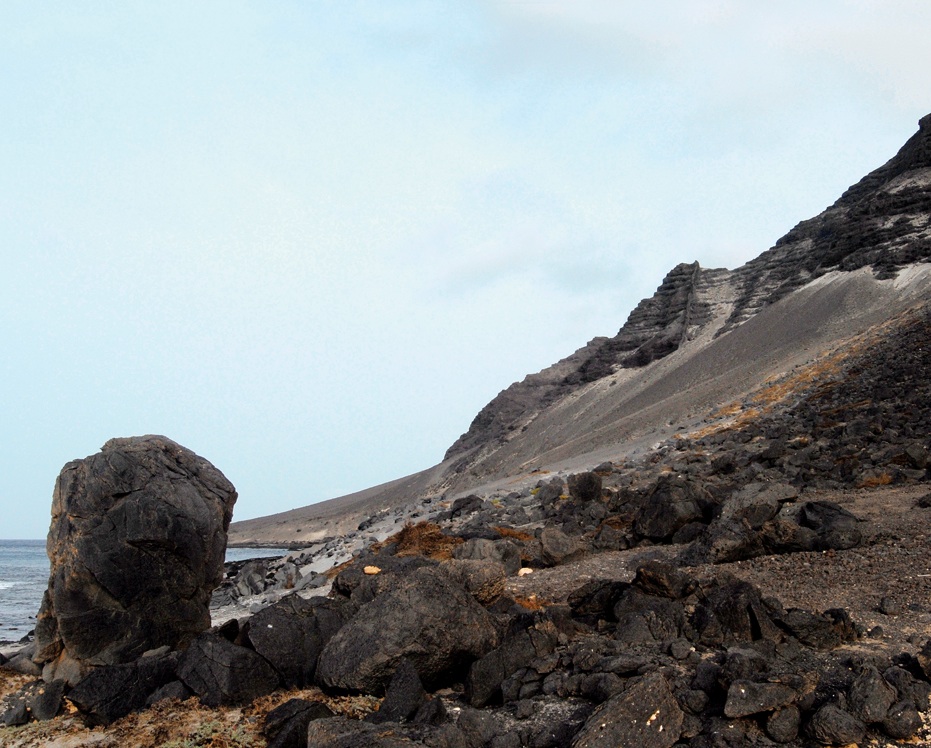
Cape Verde Storm Petrel Oceanodroma jabejabe colony, Branco, Cape Verde Islands, 24 March 2007 (René Pop). The birds breed mainly under loose rocks on the steeper slopes. CD2-59 was recorded here.
To make a good recording, I needed somehow to shield the microphones from the clamour of the sea, while capturing the best of the petrels’ performance. Under the bright, crescent moon, it was easy to see my way around, and I searched for a suitable sized rock. I tried several, but none of them were quite the right shape or size. Eventually I lay down on my side, using my body to block out some more surf from the sea. Storm petrels were flying very low, sometimes almost touching me with their wings (CD2-59). Thanks to the moonlight, very few Cape Verde Shearwaters C edwardsii were calling at this hour.
CD2-59: Cape Verde Storm Petrel Oceanodroma jabejabe, Branco, Cape Verde Islands, 20:14, 23 March 2007. Massed display flights over a large colony. Most of the calls that can be heard are chatter calls. At 0:54 you can hear a harsh, possibly aggressive call as two birds meet in mid-air. Background: Boyd’s Shearwater Puffinus boydi and surf. 070323.MR.201428.00
As soon as you listen to CD2-59, you will notice how different Cape Verde Storm Petrels sound compared to their relatives from the Azores to the Berlengas, a couple of thousand kilometres further north. Quite simply, they put a lot more chatter into their chatter calls, which can contain anything from 11 to about 16 notes. Compare this to the four to six notes of Monteiro’s, nine of Grant’s and six to 11 of Madeiran. Cape Verde’s local name is ‘jabe-jabe’, which is a handy abbreviation for jabe, dab’di, jabedabede-jabe-jabe, or something along those lines! When Portuguese naturalist J V Barbosa du Bocage first described Cape Verde Storm Petrel, as long ago as 1875, he adopted jabejabe as its scientific name. The type specimen was collected on Raso, and sent to him by Francisco Frederico Hopffer, a doctor living in the Cape Verde Islands at the time (Hazevoet 1995).
In Cape Verde Storm Petrel, the climax of pitch and intensity in the chatter call usually comes in the middle section, which is especially long. All other band-rumped storm petrels do the reverse, becoming louder towards the end. The presumed male Cape Verde at 0:01 in CD2-60 actually sounds loudest at the start, but only because he was flying rapidly away from the microphones. I recorded him on Raso, where he was almost the only storm petrel calling at the time.
Male and female Cape Verde Storm Petrels are easy to tell apart by their voice, assuming that the same rule applies as in other band-rumped storm petrels (James & Robertson 1985e, Smith & Friesen 2007). Until this has actually been proven, however, sexing of Cape Verde should be treated as provisional, as in Grant’s and Monteiro’s Storm Petrels. In CD2-61, you can hear a presumed female I recorded flying along the same scree slope on Raso, about half an hour after the last two tracks were recorded. Another female can be heard calling in the distance.
CD2-60: Cape Verde Storm Petrel Oceanodroma jabejabe, Raso, Cape Verde Islands, 19:49, 22 March 2007. Chatter calls of a lone, presumed male. Background: Cape Verde Shearwater Calonectris edwardsii. 070322.MR.194917a.01
CD2-61: Cape Verde Storm Petrel Oceanodroma jabejabe, Raso, Cape Verde Islands, 19:49, 22 March 2007. Chatter calls of a presumed female. Background: another presumed female and Cape Verde Shearwater Calonectris edwardsii. 070322.MR.202321.01
Like other band-rumped, Cape Verde Storm Petrels sometimes give little bursts of purring in flight. The presumed male in CD2-62 purrs very briefly at the start of several chatter-like calls. From 0:27 to the end, you can hear normal chatter calls again, produced by the same male you heard in CD2-60.
CD2-62: Cape Verde Storm Petrel Oceanodroma jabejabe, Raso, Cape Verde Islands, 19:52, 22 March 2007. Aerial purring calls of a presumed male, then from 0:27, chatter calls of the presumed male from CD2-60. Background: Cape Verde Shearwater Calonectris edwardsii. 070322.MR.194917b.01
Now that you have heard these soloists from Raso, you will understand why I was so perplexed by the great chorus we heard on nearby Branco, where the first track was recorded. Where did all those thousands of storm petrels come from, and why had they been so scarce on Raso during the previous three nights? The usual explanations did not apply. Moonlight was actually stronger by the time we got to Branco, and there had been no significant change in the weather. Another mystery was that virtually all of the activity was taking place in the air. I went around searching for individuals purring in their burrows, but found not a single one. Nor did Killian, René Pop or Pim Wolf, who were looking for ‘jabe-jabes’ that they could photograph.
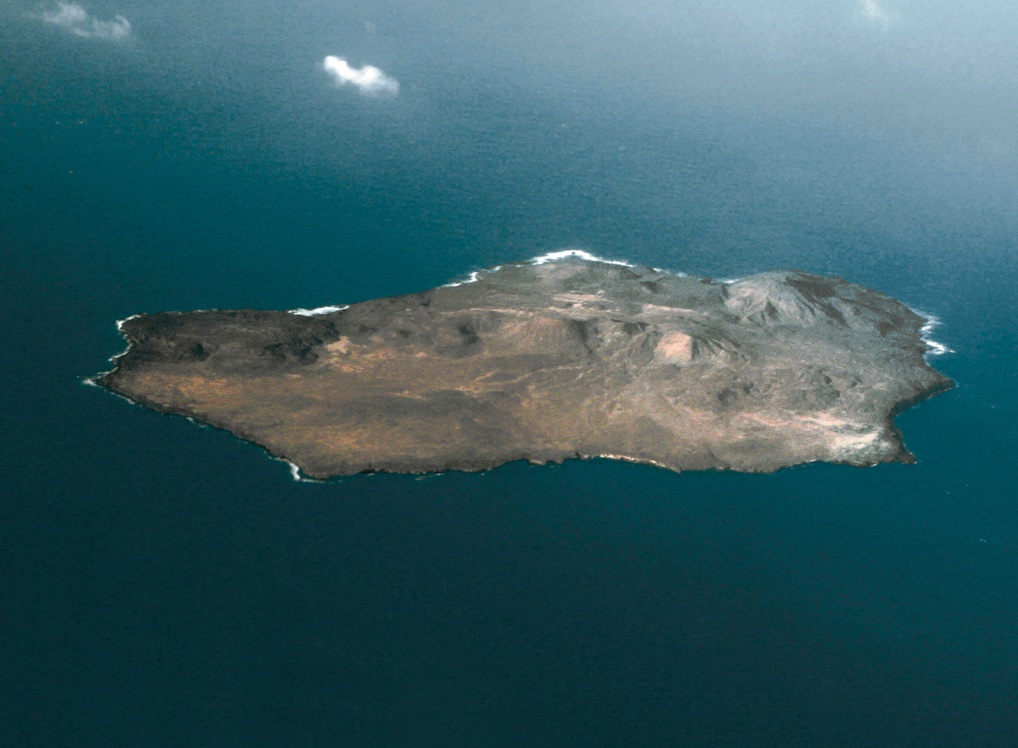
Raso, Cape Verde Islands, as seen from an airplane, 25 February 2007 (Ilse Schrama)
During the previous three nights on Raso, I did manage to find two purring males, despite the much smaller numbers of storm petrels present. In the near-silent surroundings, I picked up the first one from a surprisingly long way off. Luckily, it kept purring when I set up my microphones just outside its crevice. You can hear it in CD2-63, recorded not long after I found it. Later, its purring became more intermittent and fractured, as if it was running out of steam.
CD2-63: Cape Verde Storm Petrel Oceanodroma jabejabe, Raso, Cape Verde Islands, 22:25, 21 March 2007. Purring calls of a presumed male. Background: Cape Verde Shearwater Calonectris edwardsii. 070321.MR.222521.10
Purring of Cape Verde Storm Petrel is unmistakeable because of the almost complete chatter call that forms the flourish at the end of each ‘phrase’. Curiously, Cape Verde’s phrases tend to be amazingly long, the purring seeming to last for ages before the flourish finally arrives (Bolton 2007). Over a series of recordings, phrases of the Cape Verde in CD2-63 varied considerably in length, but averaged 23 seconds. Phrases of Grant’s, Madeiran and Monteiro’s Storm Petrels average only about two to four seconds, although they can occasionally be much longer. Perhaps Cape Verde’s purring phrases have to be long, because of the complexity of its flourish. Repeating the flourish every couple of seconds might simply be too tiring.
It took me two more nights to find another purring male, this time on the other side of Raso (CD2-64). The moon had already set behind Branco, and there were Boyd’s Shearwaters Puffinus boydi in the skies. In this individual, phrases varied from eight to 35 seconds in length.
CD2-64: Cape Verde Storm Petrel Oceanodroma jabejabe, Raso, Cape Verde Islands, 22:25, 21 March 2007. Purring calls of a presumed male. Background: Cape Verde Shearwater Calonectris edwardsii and Boyd’s Shearwater Puffinus boydi. 070321.MR.002517.01
In a recently published playback study, Mark Bolton (2007) tested the response of Cape Verde Storm Petrels to purring calls of various band-rumped storm petrels. The experiment was set up to imitate ground to air courtship, ie, purring from a burrow eliciting chatter calls from birds flying above. Cape Verdes could clearly distinguish their own purring, and preferred it to that of any of the other band-rumped. To a lesser extent, they were also attracted to purring of Grant’s Storm Petrel. In a similar test conducted in the Azores, Grant’s and Monteiro’s Storm Petrels were more fussy, showing as little interest in each other’s purring as they did in calls of the unrelated Cory’s Shearwater.
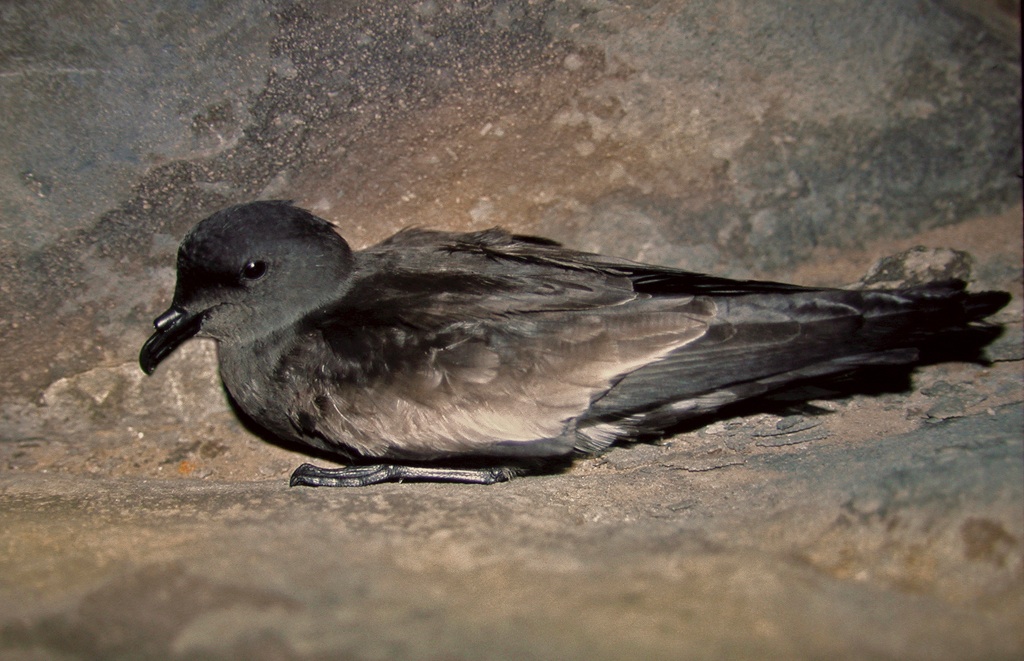
Cape Verde Storm Petrel Oceanodroma jabejabe, Raso, Cape Verde Islands, December 2002 (Mark Bolton)
The weak attraction of Cape Verde Storm Petrel to purring of Grant’s Storm Petrel might be taken to mean that they are closely related. On the other hand, Cape Verde can afford to be complacent, since unlike Grant’s and Monteiro’s, it never normally hears purring of any other storm petrel. Other species have sometimes shown a similar lack of discrimination. Leach’s and Swinhoe’s Storm Petrel O monorhis, and even Audubon’s Shearwater P lherminieri (Douglas & Zonfrillo 1997) can all be trapped with a British Storm Petrel tape lure.
Cape Verde and Grant’s Storm Petrels are not very closely related, as shown by recent studies of their mtDNA. Cape Verde is thought to have been genetically isolated from all other populations for around 200 000 to 340 000 years, although this has only been shown for females (Friesen et al 2007, Smith et al 2007). Cape Verde may even represent the oldest living branch in the band-rumped tree. Including it in Madeiran Storm Petrel makes no sense, since Madeiran is much younger, a mere twig in the same tree.
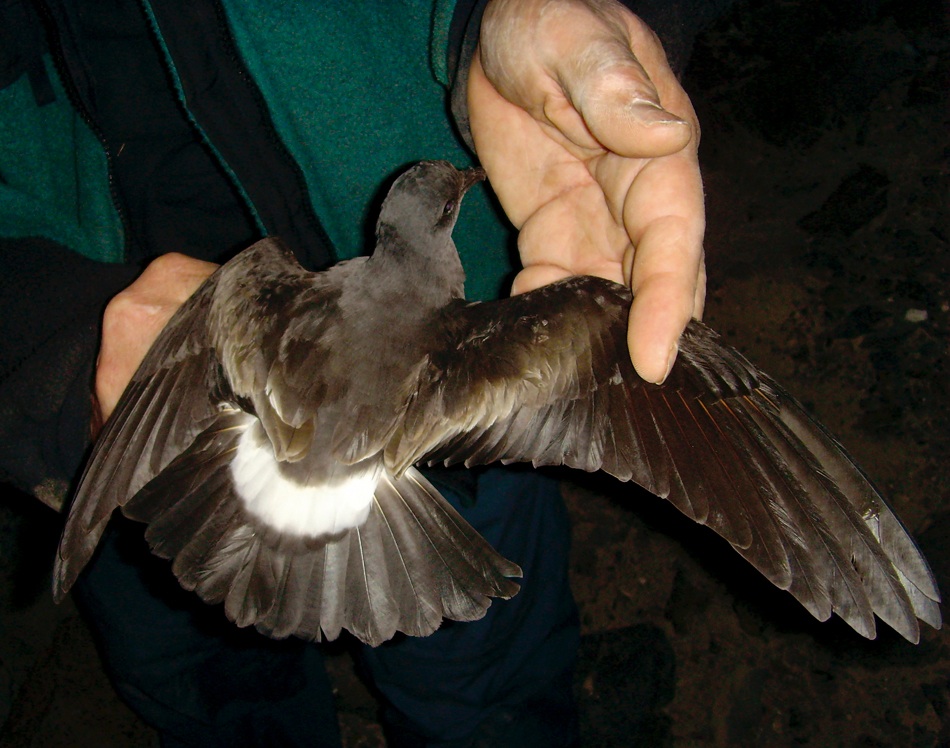
Cape Verde Storm Petrel Oceanodroma jabejabe, Branco, Cape Verde Islands, 24 March 2007 (Richard Bonser)
Little is known about this most cryptic of storm petrels; least of all, how to identify it at sea. One that I saw during a crossing from Santo Antão to São Vicente, Cape Verde Islands, in February 2007 did not have a discernible tail fork, and photographs taken on Branco by Leo Boon in March 2002 do not show one either. Moult is likely to be of limited help in identification, as Cape Verde Storm Petrels breed throughout a large part of the year. Measurements taken by Murphy (1924) from Cape Verde Storm Petrels collected in June suggest a fairly small bird, similar in size to Madeiran, and smaller than Grant’s or Monteiro’s Storm Petrels. However, the average bill measurement given by Murphy is slightly longer than that of Grant’s, Monteiro’s and Madeiran Storm Petrel.
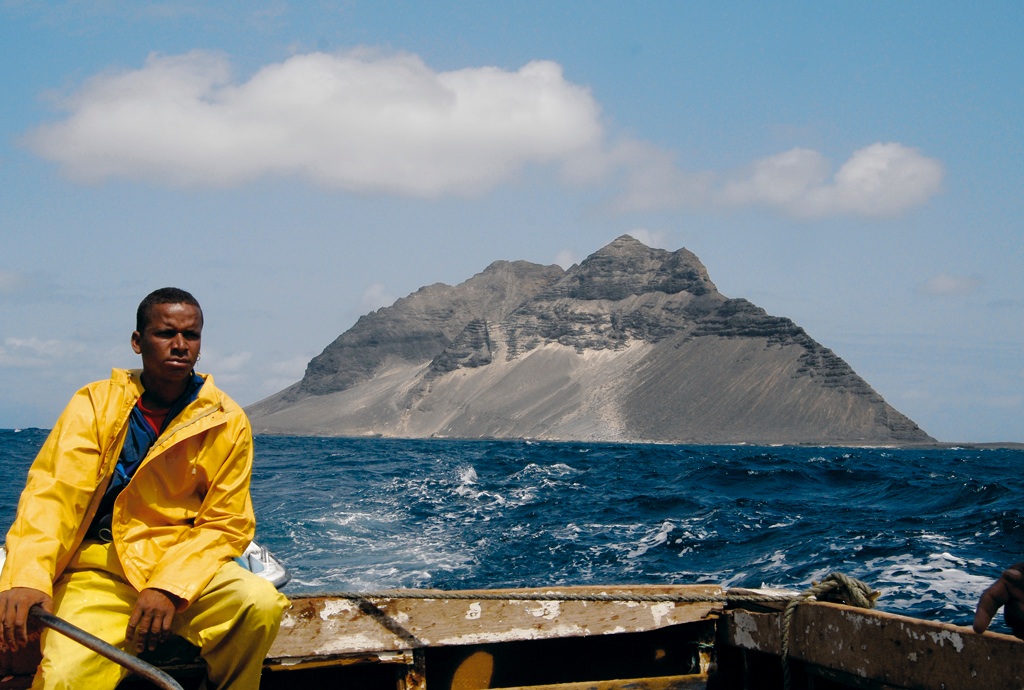
Departing from Branco, Cape Verde Islands, 24 March 2007 (René Pop)
So far, no thorough study of the timing of breeding in the Cape Verde Islands has been published. What we do know is that eggs have been found during a protracted period from October to late May, with nestlings present until at least late June (Hazevoet 1995). It has been suggested that breeding may be concentrated in two main seasons, with a changeover around March (Jacob Gonzáles-Solís in litt).
Remember the massive numbers you heard in the Branco recording (CD2-59), made on March 2007? Given that we heard very few there in February 2004, this might indeed be taken to suggest the arrival of a second population. On the other hand, Mark Bolton (in litt) has reported huge differences from night to night during a December visit to Raso: “from tens of thousands to virtually none”. So it is also possible that we just happened to visit Branco in March 2007 on one of those mysterious nights of maximum activity.
Another low-latitude breeding population of band-rumped storm petrels exists on the Galapagos Islands off Ecuador. Snow & Snow (1966) visited the Galapagos mainly to study the endemic Swallow-tailed Gull Creagrus furcatus, but during their fieldwork they also stumbled across band-rumped nests. Rechecking them over a 15-month period, they found many that were occupied during the dry season, subsequently vacated, and reoccupied during the rainy season six months later. Harris (1969, 1984) followed this up, ringing as many as 2363 adults, but finding no evidence of individuals switching between the dry and rainy season populations. Smith & Friesen (2007) have found that the populations are only very weakly differentiated in mtDNA and vocalisations. Morphologically, they differ much less than seasonal populations in the Azores or Madeira. Despite differing in bill, tarsus and wing length, dry and rainy season Galapagos birds have a similar body mass.
Lying on the equator, the Galapagos Islands experience much less seasonal climate variation than the Azores or Madeira. This smaller contrast between the seasons may explain why the seasonal Galapagos populations have been much slower to evolve differences (Smith & Friesen 2007). The Cape Verde Islands are only about 15° north of the equator, and sea surface temperatures vary relatively little there too. Cape Verde Storm Petrels are absent from their breeding colonies in September, the month with the highest sea temperatures, and consequently the least food. During the rest of the year, there may be insufficient climatic contrast to allow the evolution of two clearly separate Cape Verde populations. In sound recordings I have heard from October, December and June, all Cape Verde chatter calls sound very much the same as in the recordings presented here. If there are indeed seasonal populations, any differences in behaviour or measurements have yet to be discovered.
Although we have come a long way since the discovery of seasonal populations in the Galapagos Islands, and later in the Azores, there is much still to be investigated about these fascinating storm petrels. As George Sangster wrote in 1999: “The story that has begun to unfold is both spectacular and sobering. It is spectacular because it reveals the existence of previously unrecognized avian taxa in the Western Palearctic and presents evidence for sympatric speciation in birds. It is sobering because it illustrates that the current state of knowledge of seabirds is lacunose even in a field as basic as taxonomy”.
